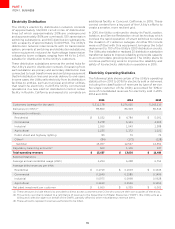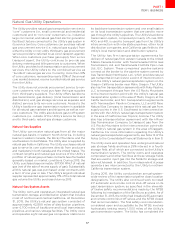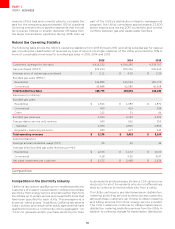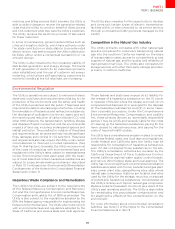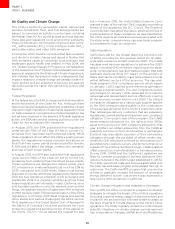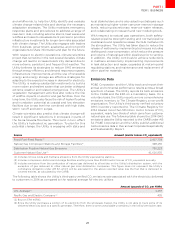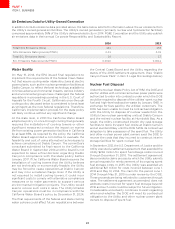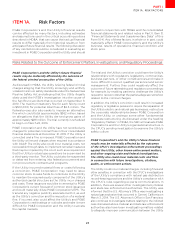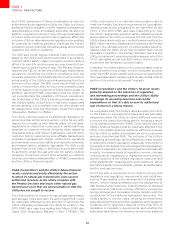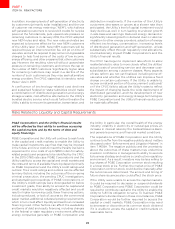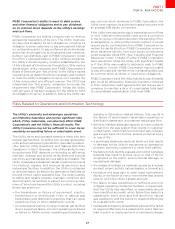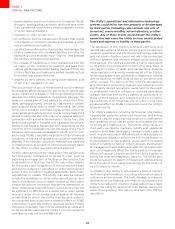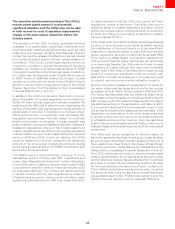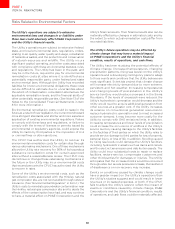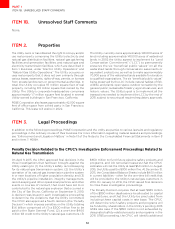PG&E 2015 Annual Report Download - page 30
Download and view the complete annual report
Please find page 30 of the 2015 PG&E annual report below. You can navigate through the pages in the report by either clicking on the pages listed below, or by using the keyword search tool below to find specific information within the annual report.
22
PART I
ITEM1.BUSINESS
Air Emissions Data for Utility-Owned Generation
In addition to GHG emissions data provided above, the table below sets forth information about the air emissions from
the Utility’s owned generation facilities. The Utility’s owned generation (primarily nuclear and hydroelectric facilities)
comprised approximately 36% of the Utility’s delivered electricity in 2014. PG&E Corporation and the Utility also publish
air emissions data in their annual Corporate Responsibility and Sustainability Report.
TotalNOxEmissions(tons)
NOxEmissionsRate(poundsMWh)
TotalSOEmissions(tons)
SOEmissionsRate(poundsMWh)
Water Quality
On May 19, 2014, the EPA issued final regulations to
implement the requirements of the federal Clean Water
Act that require cooling water intake structures at electric
power plants, such as the nuclear generation facilities at
Diablo Canyon, to reflect the best technology available to
minimize adverse environmental impacts. Various industry
and environmental groups have challenged the federal
regulations in proceedings pending in the U.S. Court of
Appeals for the Fourth Circuit. California’s once-through
cooling policy discussed below is considered to be at least
as stringent as the new federal regulations. Therefore,
California’s implementation process for the state policy
will likely continue without any significant change.
At the state level, in 2010 the California Water Board
adopted a policy on once-through cooling that generally
requires the installation of cooling towers or other
significant measures to reduce the impact on marine
life from existing power generation facilities in California
by at least 85%. As required by the policy the California
Water Board appointed a committee to evaluate the
feasibility and cost of using alternative technologies to
achieve compliance at Diablo Canyon. The committee’s
consultant submitted its final report to the California
Water Board in September 2014 and the board is not
expected to issue a final decision regarding Diablo
Canyon’s compliance with the state policy before
January 2017. If the California Water Board requires the
installation of cooling towers that the Utility believes
are not technically or economically feasible, the Utility
may be forced to cease operations at Diablo Canyon
and may incur a material charge. Even if the Utility is
not required to install cooling towers, it could incur
significant costs to comply with alternative compliances
measures or to make payments to support various
environmental mitigation projects. The Utility would
seek to recover such costs in rates. The Utility’s Diablo
Canyon operations must be in compliance with the
California Water Board’s policy by December 31, 2024.
The final requirements of the federal and state cooling
water policies could aect future negotiations between
the Central Coast Board and the Utility regarding the
status of the 2003 settlement agreement. (See “Diablo
Canyon Power Plant” in Item 3. Legal Proceedings below.)
Nuclear Fuel Disposal
Under the Nuclear Waste Policy Act of 1982, the DOE and
electric utilities with commercial nuclear power plants were
authorized to enter into contracts under which the DOE
would be required to dispose of the utilities’ spent nuclear
fuel and high-level radioactive waste by January 1998, in
exchange for fees paid by the utilities’ customers. The
DOE has been unable to meet its contractual obligation
with the Utility to dispose of nuclear waste from the
Utility’s two nuclear generating units at Diablo Canyon
and the retired nuclear facility at Humboldt Bay. As a
result, the Utility constructed interim dry cask storage
facilities to store its spent fuel onsite at Diablo Canyon
and at Humboldt Bay until the DOE fulfills its contractual
obligation to take possession of the spent fuel. The Utility
and other nuclear power plant owners sued the DOE to
recover the costs that they incurred to construct interim
storage facilities for spent nuclear fuel.
In September 2012, the U.S. Department of Justice and the
Utility executed a settlement agreement that awarded the
Utility $266 million for spent fuel storage costs incurred
through December 31, 2010. The settlement agreement
also provided a claims process by which the Utility submits
annual requests for reimbursement of its ongoing spent
fuel storage costs. In 2015, the Utility was awarded an
additional $21 million for costs incurred between June 1,
2013 and May 31, 2014. The claim for the period June 1,
2014 through May 31, 2015 is under review by the DOE.
These proceeds are being refunded to customers through
rates. The settlement agreement, as amended, does not
address costs incurred for spent fuel storage beyond
2016 and such costs could be subject to future litigation.
Considerable uncertainty continues to exist regarding
when and whether the DOE will meet its contractual
obligation to the Utility and other nuclear power plant
owners to dispose of spent fuel.






